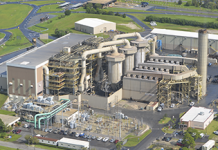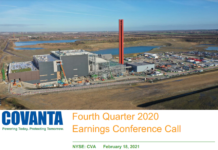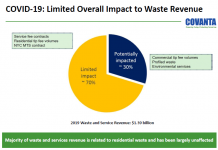by Debra Fiakas CFA
Covanta Holding Corp. (CVA: NYSE) is among the largest waste-to-energy developers and producers in the U.S. The company couples waste collection services for local government and industry with power generation for local municipal or commercial customers. Covanta’s waste handling and ‘mass-burn’ process also allows for metal recovery and sales. The company operates forty-six waste-to-energy facilities mostly in North America supported by eighteen waste transfer stations and four ash landfills.
Covanta is a big player in the waste-to-energy industry, but what kind of yield does it’s stock offer investors?
Covanta’s management team knows the pain of failure as well as the pride of success. A decade ago Covanta was struggling to emerge from bankruptcy, but in the most recently reported twelve months the company reported a net profit of $47.0 million on $1.7 billion in total sales. Granted Covanta is highly leveraged, carrying $2.3 billion in debt on its balance sheet that generates a 265.0 debt-to-equity ratio. However, the debt-laden balance sheet is supported by strong cash flow generation. Covanta turned 21.6% of sales in the last twelve month period into operating cash flow. That helped bring cash on the balance sheet to $175 million at the end of June 2014. Additionally, a new cost saving program initiated in June 2014, is expected to bring an incremental $30 million to the profit line.
One of the reasons Covanta has been able to crank up cash flow generation is by offering a mix of business models for its municipal partners. Most of its projects follow a design-build-operate model wherein Covanta gets paid for waste collection and then shares in revenue from the sales of power. Covanta is even gets guarantees of minimum waste streams by its municipal partner. Alternatively, Covanta assumes ownership of the waste-to-energy plant and keeps all power revenue for itself.
Besides the municipal waste-to-energy model Covanta has interests in seven wood-fired generation facilities in California and Maine. The company also has partial interests in two hydroelectric power plants in Washington and is the owner/operator of a landfill gas to energy plant in Massachusetts.
The Company projects its portfolio of power plants could generate 6.5 megawatt hours of electricity in 2014. The waste-to-energy group represents 88% of the total.
Earnings, Growth and Yield
As mentioned above the portfolio generates fairly strong cash flows that can be used reinvested or used for debt-pay down. Covanta recently announced an increase in its dividend to $1.00 per year. At the current stock price near $21.00 that dividend represents a yield of 4.8%. Even with this payout to common stockholders, analysts watching the company are expecting about 13% earnings growth over the next five years.
Investors looking at Covanta’s cash flows and dividend yield might be impressed until they look at the stock’s price/earnings ratio of 35.8 times projected 2015 earnings. The ‘PEG’ or price-earnings to growth ratio is 2.75 ($21.50/$0.60). The stock looks just ‘flat out expensive.’
In my view, the fundamental analysis should not stop there. Since the stock pays a good dividend, the current yield should be considered. The ratio of price-earnings to growth-plus-yield or ‘PEGY’ is a bit more palatable at 2.01 [35.8/(13 + 4.8)]. Even this is not a full analysis of the investment picture for Covanta. CVA shares represent a well-season security with deep trading volumes, strong institutional ownership and low price volatility. So I argue that the PEGY ratio should be adjusted for risk as measured by beta, which for CVA is a relatively low 0.32. On a risk adjusted basis the price-earnings to growth-plus-yield ratio or ‘PERGY’ is 0.64 (2.01 x 0.32) – well below the 1.00 maximum for this popular benchmark.
Strategy
This is no argument for investors to run to their computers and place buy orders for CVA. A review of historic trading patterns in CVA suggests the stock is over-bought in the near-term. The trend for CVA shares has been decidedly bullish since early May 2014, when the stock formed a particularly bullish trading pattern called a ‘double top breakout’ by stock chartists using point and figure analysis. The chart suggests the stock has developed sufficient momentum to rise to the $39.00 price level. That is a price that is not being bandied about by any of the fundamental analysts who watch CVA and have published price targets. The highest published price target is $26.00 and the mean target is $24.00.
At the mean price target, fundamental analysts suggest there is 14% upside in the stock. Technical analysis says there is room for 86% upside. There is probably good reason to take note of both views.
Negative news could likely trigger a retreat in the stock price, but there is a noticeable level of support at the $20.50 price level. Of course, an extreme set back could send the stock back to retrace levels in the price gap between $19.25 and $19.75, which was formed in early June 2014, after the company announced its cost saving plan and dividends increase.
The cost savings does not appear to have been registered analysts’ estimates for 2015 as the consensus estimate for next year has not budged for over four months. If the cost saving program is at all successful, it is more likely than not that Covanta could meet or beat expectations for earnings in the coming quarters. Short interest in CVA is near 13.7 million shares or about 14% of the float. Under current present trading volumes, it would take at least twelve days to liquidate short interests in CVA. Strong fundamental news from Covanta could send traders with short positions looking for an exit point and, that could push the stock price higher.
With mixed signals coming from fundamental analysis and technical analysis, investors would be well advised to watch both earnings and the stock chart in taking any position in CVA.
Debra Fiakas is the Managing Director of Crystal Equity Research, an alternative research resource on small capitalization companies in selected industries.
Neither the author of the Small Cap Strategist web log, Crystal Equity Research nor its affiliates have a beneficial interest in the companies mentioned herein.







